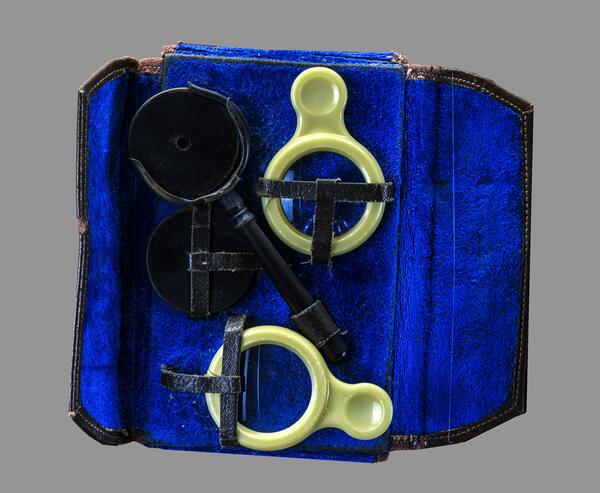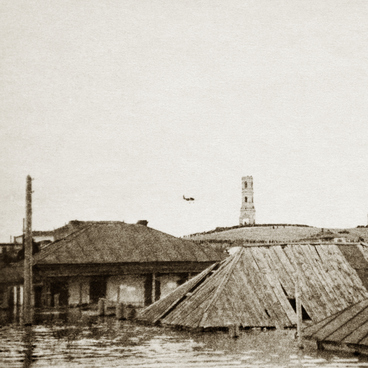This ophthalmoscope (a looking glass for the eyes) was invented by German doctor and physician, Hermann von Helmholtz in 1851, to light up and examine the fundus of the eye. The medical instrument allows doctors to establish objective data to diagnose many conditions. An ophthalmoscope makes it possible to see changes in the retina, ocular nerves and the vascular membranes. That is why these examinations of the fundus of the eye are so important - not only for eye conditions, but also for neurological research, cardiovascular diseases and hypertension.
At 34 years of age, he was appointed chief physician at State Hospital № 2. It was during these years that Vladimir Iosifovich had a burning desire to establish an emergency surgical department at the hospital in Orsk. As a result of achieving his goal, he operated a great deal and took on the most complex of patients. The operations were performed on varicose veins, goiters, bowl conditions of varying complexity. In 2000, he was named an honored citizen of Orsk. He died in 2008.
This medical instrument belonged to an Orsk native, doctor and ophthalmologist, Maria Vasilievna Kamshilina. Maria Vasilievna graduated from the Kuybyshevskiy Medical Institute and worked as a doctor in Kreking, near Orsk. In 1940 she specialized as an ophthalmologist in Kazan and became the first eye doctor in Orsk. In the 1950’s, she was awarded with a medal ‘For Valiant Labor in the Great Patriotic War’ and ‘An Excellent Worker’.
In the Soviet years, Orsk’s businesses invested heavily in the construction and provision of medical facilities with all the requisite equipment. Residents received free healthcare in these facilities. Healthcare developed significantly.
In 1953, there were 5 ambulance stations, 4 maternity departments, 14 nurseries and 4 pediatric consultants. At the beginning of the 1960’s, medical facilities opened at the YUMZ clothing factory and motor transport convoy № 1175, whilst healthcare received increased funding from the city’s budget. At the behest of the Ministry of Emergency Situations, functional diagnostic rooms and physical assessment rooms equipped with the latest technology were established at the Southern Urals Mechanical Factory, the Chkalov factory. In 1968, specialized dental clinics appeared in Orsk Oblast. In the 1970’s, there were 21 hospitals, 14 polyclinics, with a maximum hospital capacity of 3500 patients. In the 1980’s, healthcare facilities were built at the Southern Ural Nickel Plant (with 200 beds) and the Orsk Tractor Trailer Plant (with 100 beds). There were seven similar healthcare centers in the city, where factory workers could recuperate. Vouchers were spread through trade union business committees, which meant workers only had to pay a 1/3 of the cost of their treatment, with the company paying the rest.
One of the leading doctors at that time was surgeon Vladimir Iosifovich Nikolayuk - an honored physician of the RSFSR from 1986, who dedicated 66 years of his life to his favorite occupation.
In the Soviet years, Orsk’s businesses invested heavily in the construction and provision of medical facilities with all the requisite equipment. Residents received free healthcare in these facilities. Healthcare developed significantly.
In 1953, there were 5 ambulance stations, 4 maternity departments, 14 nurseries and 4 pediatric consultants. At the beginning of the 1960’s, medical facilities opened at the YUMZ clothing factory and motor transport convoy № 1175, whilst healthcare received increased funding from the city’s budget. At the behest of the Ministry of Emergency Situations, functional diagnostic rooms and physical assessment rooms equipped with the latest technology were established at the Southern Urals Mechanical Factory, the Chkalov factory. In 1968, specialized dental clinics appeared in Orsk Oblast. In the 1970’s, there were 21 hospitals, 14 polyclinics, with a maximum hospital capacity of 3500 patients. In the 1980’s, healthcare facilities were built at the Southern Ural Nickel Plant (with 200 beds) and the Orsk Tractor Trailer Plant (with 100 beds). There were seven similar healthcare centers in the city, where factory workers could recuperate. Vouchers were spread through trade union business committees, which meant workers only had to pay a 1/3 of the cost of their treatment, with the company paying the rest.
One of the leading doctors at that time was surgeon Vladimir Iosifovich Nikolayuk - an honored physician of the RSFSR from 1986, who dedicated 66 years of his life to his favorite occupation.
At 34 years of age, he was appointed chief physician at State Hospital № 2. It was during these years that Vladimir Iosifovich had a burning desire to establish an emergency surgical department at the hospital in Orsk. As a result of achieving his goal, he operated a great deal and took on the most complex of patients. The operations were performed on varicose veins, goiters, bowl conditions of varying complexity. In 2000, he was named an honored citizen of Orsk. He died in 2008.



